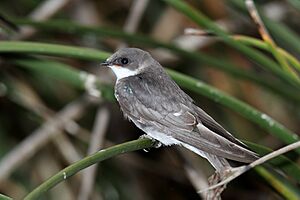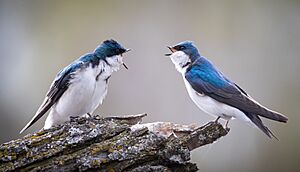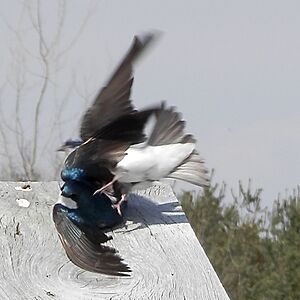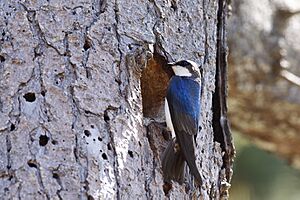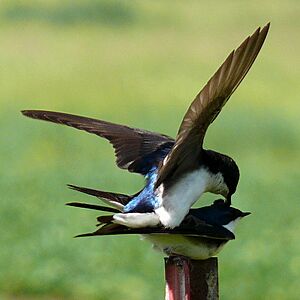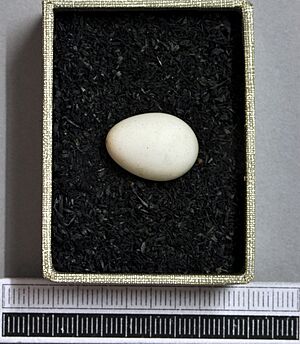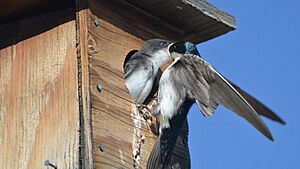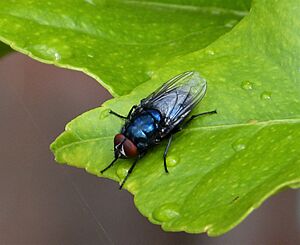Tree swallow facts for kids
Quick facts for kids Tree swallow |
|
|---|---|
 |
|
| An adult tree swallow in Jamaica Bay Wildlife Refuge | |
| Conservation status | |
| Scientific classification | |
| Genus: |
Tachycineta
|
| Species: |
bicolor
|
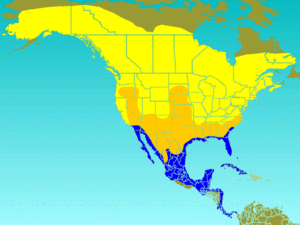 |
|
| Where the tree swallow lives: Breeding summer visitor Migration visitor Winter visitor | |
| Synonyms | |
|
Hirundo bicolor Vieillot, 1808 |
|
The tree swallow (Tachycineta bicolor) is a migratory bird that belongs to the Hirundinidae family. These birds are found in the Americas. A French scientist named Louis Vieillot first described the tree swallow in 1807. He called it Hirundo bicolor. Later, it was moved to its current group, Tachycineta.
Tree swallows have shiny blue-green feathers on their back and head. Their wings and tail are blackish, and their belly is white. Their beak is black, eyes are dark brown, and legs and feet are light brown. Female tree swallows are usually not as bright as males. Young females often have brown backs with some blue feathers. Baby swallows are brown on top with a grey-brown chest.
Tree swallows build their nests in the US and Canada. They spend their winters along the southern US coasts, down to Panama, and on the northwestern coast of South America. They also winter in the West Indies.
Tree swallows nest alone or in small groups. They use natural holes or special nest boxes. Breeding can start in early May and last until July. These birds usually have one partner, but some males might have more. The female sits on two to eight (but usually four to seven) pure white eggs for about 14 to 15 days. The chicks hatch at slightly different times. This helps the mother decide which chicks to feed if there isn't enough food. Young swallows usually leave the nest about 18 to 22 days after hatching.
Tree swallows eat insects while flying. They also eat molluscs, spiders, and fruit. Both parents feed insects to their babies. These swallows can get parasites, but they usually don't harm the babies much. The tree swallow is considered a bird of "least concern" by the International Union for Conservation of Nature. This is because they live in a large area and their numbers are stable. In the US, they are protected by the Migratory Bird Treaty Act of 1918. In Canada, they are protected by the Migratory Birds Convention Act. Human activities, like cutting down forests, can harm these birds. Lakes that are acidic can make it hard for them to find calcium-rich food for their chicks.
Contents
Tree Swallow Names and History
Louis Pierre Vieillot first described the tree swallow in 1807. He named it Hirundo bicolor. Later, in 1850, Jean Cabanis placed it in the group Tachycineta. The name Tachycineta comes from an Ancient Greek word meaning "moving quickly." The word bicolor is Latin and means "two-coloured," which describes its blue-green and white feathers. Sometimes, the tree swallow is also called the white-bellied swallow because of its white belly.
Scientists are still studying how the tree swallow is related to other birds in the Tachycineta group.
What Does a Tree Swallow Look Like?
Tree swallows are about 12 to 14 centimeters (5 to 5.5 inches) long. They weigh about 17 to 25.5 grams (0.6 to 0.9 ounces). Their wingspan is about 30 to 35 centimeters (12 to 14 inches).
Male tree swallows have shiny blue-green feathers on their back and head. Their wings and tail are blackish. Their belly and cheek patches are white. Their beak is black, eyes are dark brown, and legs and feet are light brown.
Female tree swallows are not as brightly colored as males. Some females might have a brown forehead. Young females often have brown backs with some blue feathers. Scientists think this might help younger females explore new nesting spots. Older males might be less aggressive towards them.
Young tree swallows look different. They have brown feathers on their back and a grey-brown chest.
Tree Swallow Sounds
The tree swallow's song has three parts: the chirp, the whine, and the gurgle. They can repeat these parts or leave them out.
- Chirp: Both male and female swallows use this call. It encourages their babies to beg for food. Sometimes, they use it when their partner leaves or enters the nest.
- Whine: This call sounds like a downward and then upward shift in sound. It can be used alone as an "anxiety call" when predators are near.
- Gurgle: This sound is often heard at the end of their song. It helps male and female swallows bond with each other.
- Chatter: This call is used to show off nest sites. It also warns other swallows to stay away from their nesting area.
- Submission call: This short, high-pitched call is sometimes made after a fight with another tree swallow.
- Distress call: If a swallow is held or in pain, it might make this call.
- Aggression call: Both males and females make a ticking or rasping sound. They use it when diving at intruders near their nest.
- Alarm call: This call warns other swallows about predators. It can make older baby swallows crouch down and stop begging for food.
Human-made noise can make it harder for parents and babies to communicate. Studies show that baby swallows might not respond to alarm calls as well when there is a lot of noise. This could make them more likely to be caught by predators.
Where Tree Swallows Live
Tree swallows breed in North America. Their breeding range goes from north-central Alaska up to the tree line in Canada. They are found as far south as Tennessee in the east. In the west, they reach California and New Mexico. They are sometimes seen breeding even further south in the US. Very rarely, they are found in the Arctic Circle, the northern Pacific, Greenland, and Europe.
In winter, they fly south. Their winter home stretches from California and Arizona in the west to southeastern Virginia in the east. It continues along the Gulf Coast to the West Indies, Panama, and the northwestern coast of South America. During migration, they often stop at places for about 57 days in autumn. They usually use one of three main routes to fly south. When they return to nest, they usually go back to the same breeding spots.
Tree swallows like to breed in open areas and woodlands, especially near water. At night, when they are not breeding, they rest in tall grasses like cane or reed beds over water. They also rest over land, on trees, and on wires. Their resting spots are usually about 100 to 150 kilometers (60 to 90 miles) apart.
Tree Swallow Behavior
Scientists study tree swallows a lot because they are easy to observe. They willingly nest in special nest boxes. During the breeding season, they can be aggressive. But outside of breeding, they are very social. They form large groups, sometimes with thousands of birds.
Tree Swallow Reproduction and Life Cycle
Tree swallows build nests in places that already have holes. These can be natural holes in trees or artificial nest boxes. In the past, they only nested in forests. But with nest boxes, they can now live in open areas too.
Most tree swallows return to the same nesting area each year. Only a small number of females (about 14%) and males (about 4%) choose a new spot. When they do move, it's usually not far, less than 10 kilometers (6 miles) from their old home. If a female doesn't successfully raise chicks, she is more likely to move to a new spot.
Tree swallows nest alone or in loose groups. In groups, nests are usually at least 10 to 15 meters (33 to 49 feet) apart. Nests that are closer together usually have eggs laid at different times. In natural holes, nests are about 27 meters (89 feet) apart. These nest holes are usually about 3.4 meters (11 feet) above the ground. Higher holes might be safer from predators.
The male tree swallow will perch near a chosen nest site and call often. If there aren't enough nesting spots, birds might fight, and sometimes even die. Tree swallows usually defend an area around their nest. They block the entrance to their nest and chase away other birds.
The female builds the nest cup using grass, moss, pine needles, and water plants. The male helps by gathering feathers to line the nest. These feathers help keep the eggs and chicks warm. This can help the eggs hatch faster and prevent the chicks from getting too cold.
During courtship, a male tree swallow might attack an unknown female. The female might flutter her wings to invite the male to court her. The male might then stand tall with his tail raised and wings slightly drooped. The female will try to land on his back, but he will fly away to prevent it. This is repeated. After courting, the male flies to his chosen nest site, and the female checks it out.
Eggs are laid from early May to mid-June. However, this is happening earlier now due to climate change. Chicks leave the nest between mid-June and July. Females who are older or have longer wings (which helps them find food) tend to lay eggs earlier.
Tree swallows usually have one partner. However, up to 8% of males might have more than one partner. This can happen if there are good conditions, like plenty of food. This allows females to lay more eggs even if they don't get help with foraging.
Tree swallows lay two to eight eggs, but usually four to seven. The eggs are pure white and about 19 by 14 millimeters (0.75 by 0.55 inches). The female sits on the eggs for 11 to 20 days, but most hatch after 14 to 15 days. About 88% of nests produce at least one chick. Bad weather or a younger female can lower this number.
The eggs usually hatch in the order they were laid. They hatch slightly at different times, with about 28 hours between the first and last chick. This can mean that earlier-hatched chicks are heavier. This helps the mother decide which chicks to feed during food shortages.
The environment affects how well baby tree swallows grow and survive. Warmer temperatures help younger chicks grow faster. Chicks that hatch later grow slower. Older chicks grow faster when there are many insects. Young tree swallows can control their body temperature well by about 9.5 days old. Chicks usually leave the nest after about 18 to 22 days. About 80% of chicks successfully leave the nest. Bad weather and younger females can also negatively affect this. Snakes and raccoons sometimes eat chicks.
Tree Swallow Feeding Habits
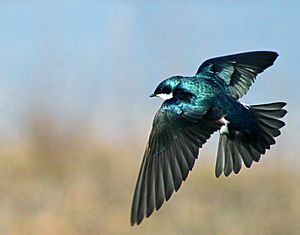
Tree swallows fly up to 50 meters (164 feet) above the ground to find food. They fly alone or in groups. During breeding season, they usually stay within 4 kilometers (2.5 miles) of their nest. When feeding their babies, they usually stay within 200 meters (656 feet) of the nest. They catch insects while flying. Sometimes, they pick insects from the ground, water, plants, or vertical surfaces.
Tree swallows mostly eat insects. They also eat some molluscs, spiders, and fruit. In North America, flies make up about 40% of their diet. They also eat beetles and ants. Aquatic insects are important because they provide healthy fats called omega-3 fatty acids. They also eat seeds and berries, especially from the Myrica plant, in all seasons except summer.
Both male and female swallows feed their babies. Males feed them less than females. Parents often use a chirp call to make the babies beg for food. They use this call more often with younger chicks. Chicks that hatched earlier usually get fed more. Chicks closer to the nest entrance are also more likely to be fed. The overall feeding rate for a group of chicks increases when they beg more.
The babies' diet is mostly insects. These insects are usually up to 10 millimeters (0.4 inches) long, but sometimes they can be up to 60 millimeters (2.4 inches) long. In nests near lakes made acidic by humans, it's harder to find calcium-rich foods. These include fish bones, crayfish shells, clam shells, and bird eggshells. This forces adult swallows to fly further, sometimes up to 650 meters (0.4 miles) away, to find these calcium sources.
Tree Swallow Survival
Tree swallows live for about 2.7 years on average. The oldest recorded tree swallow lived for 12 years. About 79% of young swallows do not survive their first year. Those that do survive face a 40% to 60% chance of dying each year. Most deaths are likely due to cold weather, which makes it hard to find insects, leading to starvation.
Predators of Tree Swallows
Many animals prey on tree swallows. Eggs, chicks, and adults in the nest can be eaten by:
- Black rat snakes
- American crows
- American kestrels
- Common grackles
- Northern flickers
- Chipmunks
- Deermice
- Domestic cats
- Weasels
- American black bears
- Raccoons
When flying or perched, tree swallows can be hunted by:
- American kestrels
- Black-billed magpies
- Barred owls
- Great horned owls
- Merlins
- Peregrine falcons
- Sharp-shinned hawks
When a predator is near, swallows usually fly away quickly. But around the nest, they often mob (swarm and dive at) predators. They also mob other birds that might compete for nest sites. They dive towards the intruder from about 5 to 20 meters (16 to 66 feet) above the ground. They usually make soft ticking calls and get very close to the predator. Tree swallows seem to attack more strongly depending on the predator. For example, they defend more vigorously against ferrets than against black rat snakes.
Tree Swallow Parasites
Tree swallows can get different parasites. These include blood parasites like Trypanosoma. They can also get fleas and feather mites. There are often more fleas on a bird if it is caring for more young. This might be because a larger group of chicks creates a better environment for fleas.
Baby swallows can also get parasites like blow-flies. These flies feed on the chicks' blood. However, these parasites are found in most nests and usually don't harm the chicks much. One study found that blow-fly parasites only explained a small part of the differences in chick weight.
Tree Swallow Health
The immune system of female tree swallows changes with age. Their ability to fight off some infections decreases as they get older. This means older females might visit their nests less if they are sick. This can cause their chicks to grow slower. Older females might also lose weight when they have an infection.
Tree Swallow Conservation Status
The tree swallow is listed as a species of "least concern" by the International Union for Conservation of Nature. This is because they live in a very large area, about 834,000 square kilometers (322,000 square miles). Their population is also stable, with an estimated 20,000,000 individuals.
They are protected in the US by the Migratory Bird Treaty Act of 1918. In Canada, they are protected by the Migratory Birds Convention Act. In some parts of the US, tree swallows have spread further south. This is likely due to changes in land use, the return of beavers, and nest boxes put out for bluebirds.
However, human activities can still negatively affect tree swallows. Clearing forests and reducing marshlands reduce their habitat. Tree swallows also have to compete for nest sites with other birds. These include the common starling, house sparrow (both introduced to North America), bluebirds, and the house wren. House wrens even destroy nests without using them themselves.
Lakes that are acidic can force tree swallows to fly long distances to find calcium-rich food for their chicks. This can also lead to chicks accidentally eating plastic. Other chemicals, like pesticides and pollutants, can build up in their eggs. High levels of PCBs are linked to parents abandoning their eggs. Pollution from oil sands mining sites can also harm tree swallows. Chicks from polluted wetlands were much more likely to die during cold, rainy weather. Exposure to mercury can also lead to fewer chicks surviving. Cold weather events can also quickly reduce the number of insects available for them to eat.



